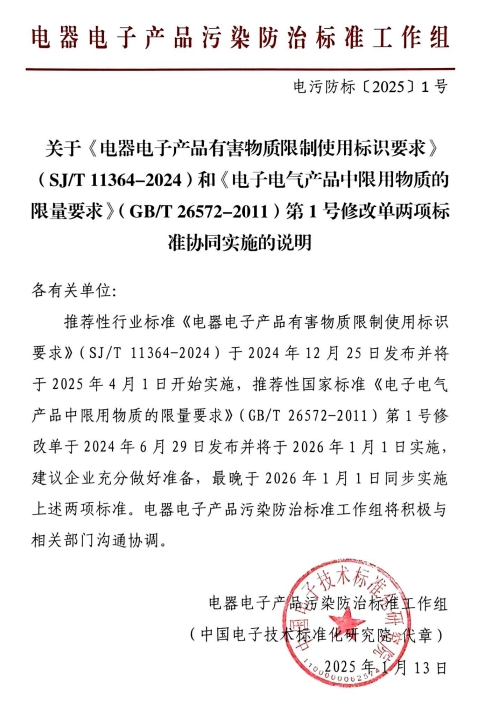
On January 13, 2025, the Working Group on Pollution Prevention and Control Standards for Electrical and Electronic Products issued an explanation on the coordinated implementation of the "Requirements for Identification of Hazardous Substances in Electrical and Electronic Products" (SJ/T11364-2024) and the "Limit Requirements for Restricted Substances in Electronic and Electrical Products" (GB/T26572-2011) Amendment No. 1.
Main changes in SJ/T 11364-2024:
1. Standard name
Adjusted from the "Requirements for Identification of Restriction of Hazardous Substances in Electronic and Electrical Products" to the "Requirements for Identification of Restriction of Hazardous Substances in Electrical and Electronic Products", consistent with the name of the "Management Measures for the Use of Hazardous Substances in Electrical and Electronic Products" in China's RoHS regulations.
2. Increase in the types of harmful substances (Normative Appendix A)
Four new phthalates have been added:
A. Di (2-ethylhexyl) phthalate (DEHP)
B. Butyl benzyl phthalate (BBP)
C. Di-n-butyl phthalate (DBP)
D. Diisobutyl phthalate (DIBP)
The total number has been expanded to 10, which is consistent with the substance scope of the EU RoHS regulation.
3. Update and optimization of the content of the hazardous substance content information table
Increase from a table of 6 substances to an information table of 10 substance contents.
A. Merge identification method
Similar components (such as plastics, cables, etc.) with the same information can be merged into an information table to avoid duplicate labeling.
B. Notes and Supplementary Explanation
You can annotate the technical reasons for the "X" section in the information table, or provide an explanation of the optional accessory information.
C. Improved layout flexibility
The order of rows and columns in the information table can be adjusted according to the actual situation of the product.
D. Add QR code identifier:
Enterprises can provide complete information on hazardous substances through QR codes for consumers to easily view. The QR code should be accompanied by text prompts that are consistent with the packaging or instructions.
4. Diversified identification methods
A. Support webpage format:
Built in identification instructions on the company's official website, guiding consumers to access them through paper manuals and other means.
B. Built in digital identifier:
For products with image display function, the environmental protection label can be directly embedded into the product system (read-only mode).
5. Document saving requirements added
Enterprises need to keep technical documents supporting the hazardous substance information table, and the retention period shall be in accordance with relevant regulatory requirements.
Related suggestions:
With the continuous updating of standards, enterprises are facing more and more control requirements. It is recommended that companies conduct early investigations into their supply chain, pay attention to standard updates, update product information sheets, and choose appropriate labeling methods as needed to avoid compliance risks caused by regulatory updates.